________________
230
EPIGRAPHIA INDICA.
[VOL. XXII.
92nd day after the 21st year of his reign that the grant should have effect from that very year. After the due observance of all the formalities, which took full two years and seventy-two days, the deed was finally drawn up and presented on the 163rd day after his 23rd year (1.322f.). It is only from the later Sanskrit introduction, composed during the reign of Rajendra-Chola L., that we learn that Kadarattaraiyan was not a mere local chief but was a member of the Sailendra family and the lord of the country of Sri-Vishaya and that he was ruling over Kataha and had the Makara crest. Now the question arises as to how Chūļāmapivarman, the lord of Sri-Vishaya and the ruler of Kaṭaha or Kadaram, came to erect a big vihara for the Buddha at Negapatam in the heart of the distant Chola dominion and how the powerful Chola king came to grant the entire revenues of a village for the upkeep of a palli in it. It is a significant fact that the historical introduction of the Chōla king as detailed in these plates does not mention Katäha, i.e., Kaḍāram or Sri-Vishaya. And therefore the inscription leaves us entirely in the dark as to what kind of relationship existed between Kaḍärattaraiyan (i.e., the lord of Kataha) and the Chola king Rajaraja I. Nor are we given to understand the circumstances under which the grant was made, i.e., whether it was done at the request of the Kataha ruler or on the Chōla king's own initiative. But for the somewhat later Sanskrit introduction, any one, reading only the Tamil original grant, might be led to think that Kaḍārattaraiyan must have been a local chief of affluence and subordinate to the Chōla king. Now, for aught we know, Rajaraja I. was tolerant of all religious creeds prevalent in his dominion, though his special leaning was towards Saivism. In this connection, his construction of the Brihadiévara temple, called Rajarajeévara after his name, at his capital Tanjore, and the immense gifts made to it from the treasures which he had acquired as booty in the conquests of the Chera and the Pandya kings in Malai-nadu and the Chalukya king Satyaáraya, and his assumption of the significant surname Sivapadasekhara, are worth remembering. Rajaraja I, was no mean monarch. It was he that for the first time in the annals of the Chōlas maintained a large standing army which consisted of 900,000 men and which is spoken of in his inscriptions as "highly powerful and victorious". The power of his arms, as we have seen already, was felt in India from Kalinga in the north to the southern cape and beyond the seas in Ceylon; but no mention is made of Kataha, From the conquest of Kataba described in detail in the records of the 16th year onwards of the reign of Rajendra-Chōla I, we learn that it was a kingdom of considerable importance and contained many strongly fortified places such as SriVijaya, i.e., Sri-Vishaya of the Leiden plates, Pannai, Malaiyur, Mäyirudingam, Ilämuridada, Ilangasōka, Pappala, Mēvilimbangam, Vilaippandür, Takkōla, Madamalingam, Nakkavāram, etc. As such, if Rajaraja I. had really conquered Katäha, it would certainly have found mention in his historical introductions. The ommission seems to indicate that he did not conquer it. On the other hand the fact that Kaḍärattaraiyan was enabled to commence the construction of a monumental Buddhist vihara at Negapatam in the Chola country in the 21st year of Rajaraja I. and that the latter assigned the revenues of a village for the upkeep of a shrine in it might lead one to infer that the Kataba ruler must have made a successful invasion of the Chola country. This is, however, negatived for the reason that the inscription is not issued in the name of the Kaṭaha ruler but in the name of the Chōla king. Can it not therefore be said that the Kataha ruler was on friendly terms with the mighty Chola king and obtained his permission to build the vihdra in question and that the latter made endowments to a palli in it, which, as we know from the smaller Leiden plates, was called Rajarajapperumballi after the name of the Chōla king?
One other observation may be made with regard to the connection of the Buddhists with Negapatam. In the traditional account of Tirumangai-Alvär, who is described in the Guruparampard as a tendatory of the Chola king of his day, it is stated that. he once went to Nagapattanam, got inside the Buddha temple at the place, carried away the gold image that was




